Streamlining the design of cavitating marine propellers with ROM-based multi-objective shape optimization
Written by Angela Scardigli
26 August 2025
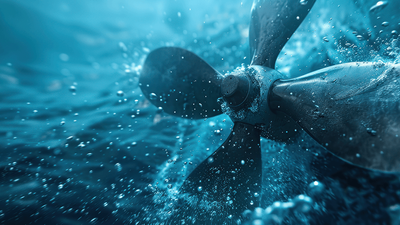
Optimizing marine propellers is critical in naval engineering. Beyond generating thrust—and thereby improving vessel performance in speed, maneuverability, and stability—optimization should also aim to reduce fuel consumption and environmental impact by maximizing propeller efficiency.
These propellers often operate in cavitating flow conditions, where small vapor-filled cavities (or bubbles) form on the blades. This cavitation generates noise and vibration that can affect passenger comfort and contribute to underwater noise pollution. Cavitation also causes blade erosion, which impacts propeller longevity and increases maintenance costs. Given these challenges, a multi-objective optimization strategy is highly desirable. However, its implementation is often limited by the high cost of computational fluid dynamics (CFD) simulations. To address this, we use the modeFRONTIER software platform to perform a multi-objective optimization study based on reduced-order models (ROMs). These models enable real-time prediction, making them well suited for evaluating many new designs quickly. They also allow us to estimate and visualize how cavitation is distributed across the propeller surface—providing far more insight than a simple cavitation index. To show how this works in practice, we applied it to the well-known Potsdam Propeller Test Case PPTC | SVA.
ROM-based multi-objective shape optimization for the Potsdam propeller
To optimize the propeller, we employ a comprehensive exploration strategy that includes Design of Experiments (DOE) with CFD simulation, reduced-order models (ROM) and multistrategy algorithms for multi-objective optimization, integrated in a series of modeFRONTIER workflows.
Our goal is to improve the original design, by focusing on three crucial performance indices:
- thrust coefficient.
- efficiency - measuring how effectively engine power is converted into thrust to propel the vessel through water.
- cavitation area ratio - defined as the ratio of the cavitation surface area to the propeller surface area.
1. CFD simulation and process automation
To simulate the propeller performance, we use a modified version of OpenFOAM’s interPhaseChangeFoam solver. It’s a volume of fluid (VOF)-based solver designed to simulate how two incompressible, isothermal, immiscible fluids interact, especially when phase changes occur. We applied a multi-rotating frame (MRF) approach to account for the propeller’s rotation . For turbulence and cavitation modeling, we used the k-ε turbulence model and Schnerr-Sauer cavitation model, which gave us the best match with experimental data. To reduce computational costs, we limited the simulation to a single blade passage. Even with that simplification, each simulation still took around 800 CPU hours to simulate two full propeller rotations. We focused on four main parameters that define blade shape: length, pitch, camber and thickness. And, we used radial basis function (RBF) parameterization to apply shape changes across 24 control points on 6 different blade sections.
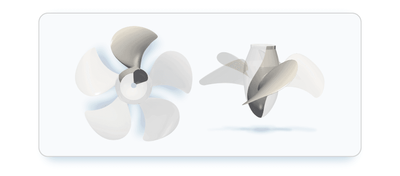
Geometry of the propeller blade
To explore how these design parameters affect performance, we set up an automated simulation workflow in modeFRONTIER. This allowed us to automate the design process. For each new set of design parameters and propeller operating conditions - kept constant in this study - the blade geometry is automatically updated and used to perform a CFD analysis, retrieving the corresponding performance indices.
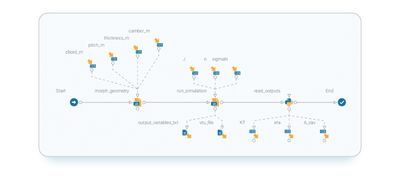
High-fidelity simulation workflow in modeFRONTIER.
We started by generating an initial Design of Experiments (DOE) with 56 designs using the Incremental Space Filler algorithm. This method maximizes the minimum distance between points.
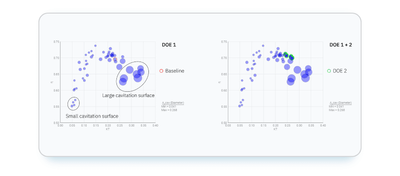
Thrust coefficient (horizontal axis), efficiency (vertical axis) and cavitation area ratio (bubble) distributions for the initial DOE (DOE 1, left) and for the enriched DOE (DOE 1+2, right).
Then, we added 16 more designs using a level 2 Full Factorial algorithm, focusing on the most promising region—where all performance metrics showed improvement over the baseline.
2. Enabling multi-objective optimization through ROMs
We trained a reduced order model (ROM) using the dataset from our initial design of experiments (DOE) to predict pressure, wall shear stress, and liquid fraction distributions across the blade surface. The goal was to replace full CFD analysis with a much faster alternative—one that still captures the key behaviors accurately enough to support multi-objective optimization of the propeller design.
We used a non-intrusive approach that combines Proper-Orthogonal Decomposition (POD) with Radial Basis Function interpolation. We validated the ROM on a set of points in the region of interest. The results showed a maximum error of less than 1% for thrust and efficiency, and under 8.3% for the cavitation area ratio. It’s worth noting that these performance indices weren’t directly predicted. Instead, we evaluated them by post-processing the fluid dynamics fields. The higher error in cavitation is expected, as tracking the interface between phases is complex even with the full CFD model, and ROMs are known to suffer when dealing with discontinuities, unless a fine sampling is provided.
We used the self-initializing pilOPT multi-objective genetic algorithm implemented in modeFRONTIER to run the optimization. It generated 5000 design points, forming a saturated Pareto frontier that represents the best trade-offs between efficiency, thrust and cavitation area. Because all evaluations were done using ROM instead of full CFD, the entire process took just about 10 minutes.
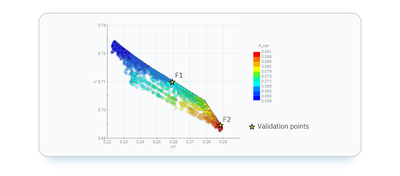
Optimization results with saturation of the Pareto front and points chosen for the a-posteriori validation.
To validate the Pareto results, we selected two points — F1 and F2 — and ran them with the high-fidelity CFD model. The accuracy was excellent: less than 0.15% error for thrust , under 0.5% for efficiency, and an underestimation of the cavitation area by less than 5%.

Comparison of CFD and ROM results over the blade for one of the validation points, in terms of pressure and gas distributions, for the pressure side (left) and suction side (right).
The optimized design, selected from the Pareto set, delivered clear performance gains compared to the baseline: 6% increase in thrust coefficient, 3% increase in efficiency and a 23.5% reduction in the cavitation area ratio. Beyond target values, the ROM also returns the fields over the blades, allowing us to assess the spatial distribution of the cavitation bubbles compared to the original design. Engineers information to adjust blade materials to improve durability and set up maintenance, inspection and monitoring protocols. The result: longer propeller lifespan and improved overall safety.
3. The benefits of using ROM with the modeFRONTIER design optimization technology
By combining high-fidelity CFD simulations, reduced order models (ROM) and multi-objective optimization strategies, we’ve shown a fast and effective way to improve marine propeller designs. Thanks to ROM, we can now simulate a full fluid dynamics solution in under one second - compared to the 800 CPU hours required for a high-fidelity CFD evaluation. That means we can run a whole multi-objective optimization, with over 5000 evaluations, in about 10 minutes - even on a small laptop. And we didn’t trade speed for accuracy. For points belonging to the Pareto front, we got very few errors:
- < 0.15% for thrust
- <0.5% for efficiency
- <5% for the cavitation area
Outside the optimal region, the model still performs well, with a maximum error of 1% for thrust and efficiency and 8.5% for cavitation. As expected, the model fails to extrapolate in regions where data is scarce. What’s next? We expect to bring other disciplines to the analysis. By combining structural analysis, materials science and acoustics with our fluid dynamics models, we can set up a framework for multidisciplinary design optimization to achieve the best design possible.
Get in touch with our experts and see how you can get instant design predictions with our XAI technology.
Interested in finding out more?
Get in touch with our experts and see how you can get instant design predictions with our XAI technology.
Interested in finding out more?
Get in touch with our experts and see how you can get instant design predictions with our XAI technology.


